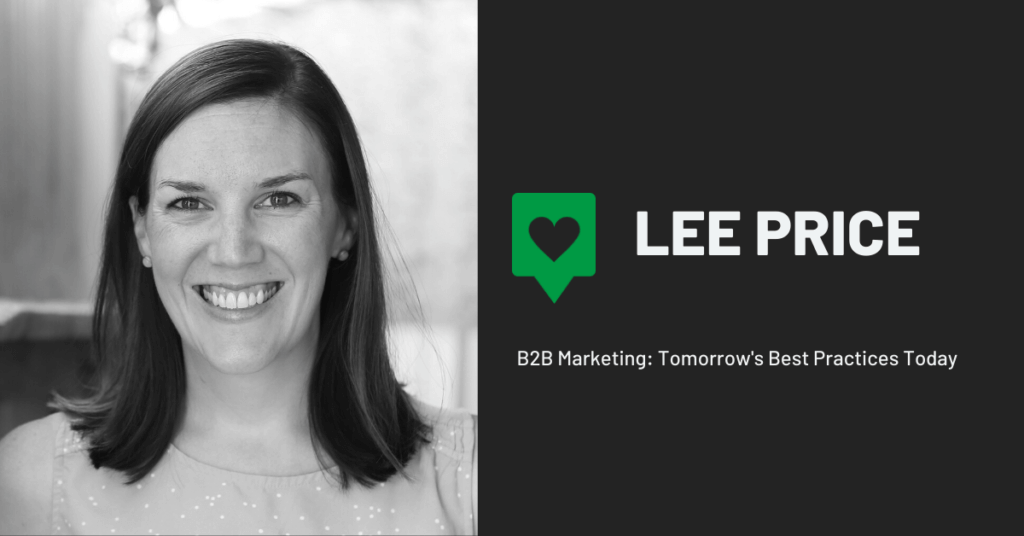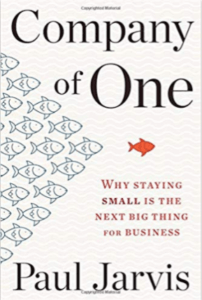In B2B Marketing: Tomorrow’s Best Practices Today, we feature expert interviews about the state of B2B Marketing and what the future holds. In this post, I interview Lee Price, a thought leadership consultant.
Tell us about yourself?
I help visionary leaders develop their big ideas.
I’m fascinated by how content marketing and thought leadership are evolving, and I consult with leaders at B2B companies to create more compelling, successful thought leadership strategies.
But back when I was a kid, I had very serious plans to be a novelist. I spent a lot of my childhood climbing trees and reading Babysitters Club books. I studied English in college, but when I graduated at the beginning of the recession, I couldn’t find my dream writing job, so I accidentally became a marketer.
More than a decade later, I have built a career that fuses my longtime predilection for words, my always-curious nature, and my ability to speak the language of the business.
My superpower is getting past the jargon and digging up the big, new idea hiding under all the business-speak.
Note: Follow Lee on Twitter: @leevprice.
Tell us about your recent transition to becoming a solopreneur?
For the past 7 years, I worked at a B2B content marketing agency, Rep Cap. My experience there gave me a comprehensive education in building a small business, working with B2B clients, and experimenting with new B2B marketing strategies.

While I was at Rep Cap, I also helped launch the agency’s brand magazine, Managing Editor, and I loved connecting with a smart community of modern marketers.
Note: Lee wrote a post at Managing Editor about thought leadership. We’ll dive deeper into thought leadership later in this post.
I recently left the agency to start my own solo consulting practice. I wanted to focus on the work I find most exciting right now — working directly with leaders who have big ideas, but aren’t sure how to best express them.
Mostly, I find myself helping people clear out their head space in order to get perspective on their work, their professional experience, and what they have learned that could be helpful for others.
I ask a LOT of questions.
Tell us about your background in B2B marketing?
“Pretty much every temporary tattoo produced in the U.S. is made in one building in Tucson, Arizona.”
I started as a B2B marketer when a lot of exciting changes were happening in marketing. I went to one of the very first INBOUND conferences, back when most people were still learning what “inbound marketing” and “content marketing” meant.
In my first job at SmartBrief, a business news publisher, I was promoting job ads to help recruiters find specialized job candidates — during a recession. That initiation by fire taught me how important it is to understand your audience and their stressors and challenges.
Later, I worked as the only marketer at a 100-person manufacturing company, where I was responsible for multiple business lines — B2C, B2B and B2B2C. Our customers were consumers making $40 orders online, and also, you know … Target.

Photo via iStockPhoto
I experimented with new strategies to reach customers using SEO, blogging, video, social media, PR and events.
I had to be scrappy and creative. Oh, and the product was a little wacky … temporary tattoos.
New trivia for you: pretty much every temporary tattoo produced in the U.S. is made in one building in Tucson, Arizona.
When I was there, they were printing 6 million tattoos a day. The product was wacky, but the job was broad, and I learned a lot.
Because of that experience, I recommend to any new marketer that they work in-house running marketing functions for an organization. It’s a free education, because every day you have to educate yourself enough to make good decisions and move the company forward.
Then, at the agency, I really developed my chops as a B2B content marketer and thought leadership coach. I got a lot of experience creating high-level B2B content — ghostwriting, reporting, driving original research, developing podcasts. And I started to create sophisticated content strategies for our clients.
A focus on content strategy
For the past few years, my focus has been on content strategy — digging deep into clients’ business problems, developing marketing strategies to solve those problems, analyzing the results and recommending updates and new approaches over time.
I have found that the platform usually isn’t what makes a campaign take off — it’s the messaging. If you have a good idea that resonates with your audience, figuring out where to put it becomes the easy part.
“Take the time to figure out your most compelling core idea before you start running campaigns and chasing clicks.”
From working with so many different companies in different industries, I have learned that: the only constant in digital marketing is change! What worked 2 years ago (or even last month) might not work today. The smartest marketers are making short-term plans to reach long-term goals, and they’re constantly pivoting based on what works.
There’s a lot of noise out there. Everyone is overwhelmed by the deluge of content and marketing messages coming from all directions. If you’re just copying your competitors, or blindly following “best practices,” your brand doesn’t have a chance of standing out.
Just publishing content isn’t enough. Get real, be authentic, and take the time to figure out your most compelling core idea before you start running campaigns and chasing clicks.
What’s a best practice that B2B marketers should move on from?

I’d like to see us move past the idea of “best practices.”
It’s so tempting to assume that the secret answer to your marketing puzzle is hiding in someone else’s work.
I love a good case study — an example to emulate — but copying each other’s work is what got us in this noisy online space.
In the early days of content marketing, it was a “best practice” for every company to have a blog, publish every day, and show up on every social media channel. These days, I think we’ve gotten a little more discerning.
It’s not about making noise in every space that will take you.
Instead, the smartest marketers I know think about the key places they can reach their most important audiences, and the key questions they can help answer. When they need a True North, they look to their audience, not their competitors or the latest buzzy best practice.
Tell us a best practice of tomorrow that B2B marketers should be doing today?
I think audio is the next frontier for people’s attention.
If you don’t have an audio strategy, it’s a good time to start thinking about it. How will you help people looking for answers through voice search? How will you share stories and news through podcasts? How will you serve your audience as they use more audio instead of screens in the coming years?

The time to start experimenting with audio is now. Good podcasts are hard to make, but I have learned a lot of helpful lessons from the ones I have developed, and I’m thankful to have that knowledge now that I couldn’t access two years ago.
I follow a couple of sources to keep learning about podcasting and how audio habits and strategies are changing: Jay Acunzo, as well as the team at Pacific Content.
Note: Follow Jay on Twitter (@jayacunzo) and visit his site, Marketing Showrunners.
You launched an email newsletter. Any early lessons to share?
Note: Subscribe to the newsletter at Lee’s website.
I have managed a lot of email newsletters for clients, and for the past two years I wrote a weekly newsletter to Managing Editor readers in my voice. So starting a new email newsletter felt instinctual, but I’m already surprised by how different this one feels.
First of all, the brand is ME, which is freeing and also a little scary. If I’m going to follow my own advice, I need to be authentic (read: vulnerable). Putting yourself out there online is always hard, but I’ve been pushing my clients to do it for years, so now I’m taking my own medicine!
“Once you lose the connection to your audience and you start thinking about emails as ‘blasts,’ you pretty much immediately lose the magic.”
And second, the list is brand-new, so I personally know most of the people I’m emailing. I’ve worked with a lot of them before, or they’re friends from the marketing world. It feels refreshing to write an email to a known audience.
That gets harder to do when your list grows and you’re not exactly sure who’s reading. I’ve always told people to pretend like they’re writing to someone they know (I usually picture my sister, who is also a marketer).
But right now, I actually am writing to people I know, which is fun. Once you lose the connection to your audience and you start thinking about emails as “blasts,” you pretty much immediately lose the magic. Email is all about trust.
I'm working on my second email newsletter, going out tomorrow. The headline is "I'm not a thought leader." (Can you guess who told me that? 🤔) Read my first send: https://t.co/uyEJeyarNY and sign up for tomorrow's email here: https://t.co/dPFb9imsjQ
— Lee Price (@leevprice) November 21, 2019
Tell us your definition of thought leadership?
“Thought leadership is about making space to reflect on your experiences, clarify your perspective, and tell people about it in a helpful way.”
This question has gotten really complicated.
Because there’s so much noise, there are a lot of voices competing for our attention, and being a “thought leader” has almost become a dirty word for some people. They don’t want to be associated with LinkedIn shucksters and self-proclaimed gurus and rockstars.
But my answer is simple.
Thought leadership is about making space to reflect on your experiences, clarify your perspective, and tell people about it in a helpful way — packaging your ideas so that other people can digest and use them.
Thought leaders aren’t necessarily the loudest people in the room, or the people with the most controversial hot takes. Thought leaders are people who have ideas and perspective, and who take the time to reflect and share that perspective.
"Thought leadership is about having perspective. It’s about looking back on years of experience and built-up expertise and offering a helpful view on an industry, or a thoughtful recommendation for a client."
I love @leevprice's newsletter; you will too! https://t.co/n7Q7hadP6H
— Meagan Nolte (@MeaganNolte) November 22, 2019
Over and over again in my work with B2B clients, I’ve seen that the most insightful thought leaders are often busy doing the work. Or they’re the people who think “Thought leader? Who, me?”
They often need help (from a marketer, a ghostwriter, or a nosy outsider like me) to dig up their big ideas, get some perspective on their experiences, and clarify their message.
Favorite book of 2019?
This one is easy: I can’t stop talking about “Company of One: Why Staying Small Is the Next Big Thing for Business” by Paul Jarvis.
As I was thinking about starting my own small business, I was looking for a new model. I was changing my career path in order to earn new control over my work and freedom over my time. I didn’t want to jump from one frenzied work routine to a new equally frenzied one.
“Company of One” helped me understand a framework for a more calm, sane work culture, with business goals that are about doing high-quality work and answering the question “What’s enough?” instead of “How big can we grow?”
Paul Jarvis’ definition of success is having a waiting list of clients who want to work with you. That vision is guiding me forward, and I’m very happy to share that at least so far, I’m seeing success and getting satisfaction from my work — without the frenzy.
I’m hopeful that this kind of framework could pull us out of our collective burnout culture.

